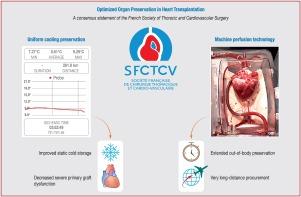Innovative approaches to organ preservation in heart transplantation: A comprehensive review by the French Society of Thoracic and Cardiovascular Surgery
IF 2.2
3区 医学
Q2 CARDIAC & CARDIOVASCULAR SYSTEMS
引用次数: 0
Abstract
Improved approaches for organ preservation have been recently applied in heart transplantation to prevent the risk of primary graft dysfunction. To review heart-graft preservation systems and to identify criteria for using innovative devices in each specific situation. A working group of the French Society of Thoracic and Cardiovascular Surgery performed a literature review focusing on organ preservation and post-transplant outcomes. Static cold storage is the most widely used method but involves cold ischaemia and is therefore limited for prolonged preservation. Optimizing this method by ensuring uniform and stable cooling (SherpaPak™) seems to be associated with favourable results, even with expanded-criteria grafts. Continuous normothermic organ perfusion (Organ Care System) shortens the cold ischaemia time, thus maintaining heart-graft viability despite long transportation times or long waits to achieve complex recipient-heart explantation. Moreover, this method can rehabilitate Maastricht III heart grafts. Continuous hypothermic oxygenated perfusion (XVivo™, not yet approved by regulatory authorities) has recently been associated with favourable outcomes, even in case of extended out-of-body preservation > 8 hours. The new devices for heart preservation can be expected to allow successful transplantation despite long transport times, lengthy explantation procedures and the use of grafts from expanded-criteria donors, including donors after controlled circulatory arrest. Further studies are needed to assess patient and graft outcomes, determine the optimal device for each situation and evaluate the cost-benefit ratio.

心脏移植中器官保存的创新方法:法国胸外科和心血管外科学会的综合综述。
器官保存的改进方法最近已应用于心脏移植,以防止原发性移植物功能障碍的风险。回顾心脏移植保存系统,并确定在每种特定情况下使用创新设备的标准。法国胸外科和心血管外科学会的一个工作组对器官保存和移植后结果进行了文献综述。静态冷藏是最广泛使用的方法,但涉及冷缺血,因此限制了长期保存。通过确保均匀和稳定的冷却(SherpaPak™)来优化这种方法似乎与有利的结果相关,即使是扩展标准的接枝。持续的恒温器官灌注(器官护理系统)缩短了冷缺血时间,从而维持心脏移植物的活力,尽管运输时间长或等待时间长,以实现复杂的受者心脏移植。此外,该方法可以修复Maastricht III型心脏移植。最近,持续低温氧灌注(XVivo™,尚未获得监管机构批准)与良好的结果相关,即使在体外保存延长至80小时的情况下也是如此。尽管运输时间长,移植程序长,使用的移植物来自扩大标准的供体,包括控制循环停止后的供体,但新的心脏保存设备有望使移植成功。需要进一步的研究来评估患者和移植物的结果,确定每种情况下的最佳装置,并评估成本效益比。
本文章由计算机程序翻译,如有差异,请以英文原文为准。
求助全文
约1分钟内获得全文
求助全文
来源期刊

Archives of Cardiovascular Diseases
医学-心血管系统
CiteScore
4.40
自引率
6.70%
发文量
87
审稿时长
34 days
期刊介绍:
The Journal publishes original peer-reviewed clinical and research articles, epidemiological studies, new methodological clinical approaches, review articles and editorials. Topics covered include coronary artery and valve diseases, interventional and pediatric cardiology, cardiovascular surgery, cardiomyopathy and heart failure, arrhythmias and stimulation, cardiovascular imaging, vascular medicine and hypertension, epidemiology and risk factors, and large multicenter studies. Archives of Cardiovascular Diseases also publishes abstracts of papers presented at the annual sessions of the Journées Européennes de la Société Française de Cardiologie and the guidelines edited by the French Society of Cardiology.
 求助内容:
求助内容: 应助结果提醒方式:
应助结果提醒方式:


